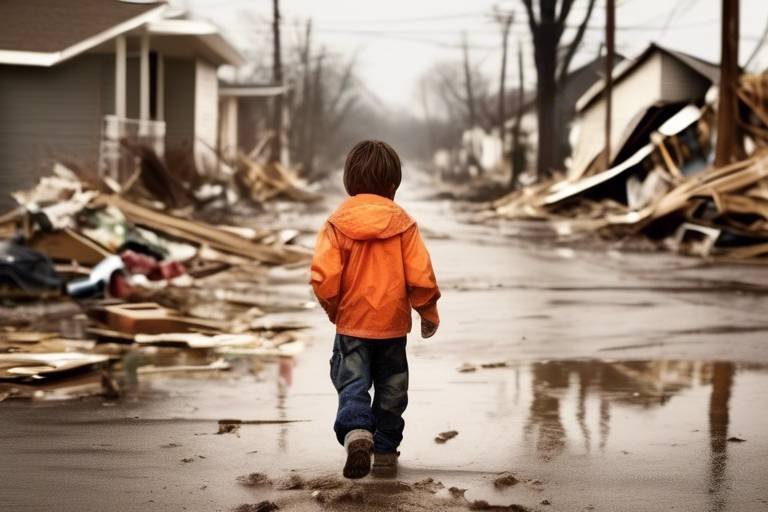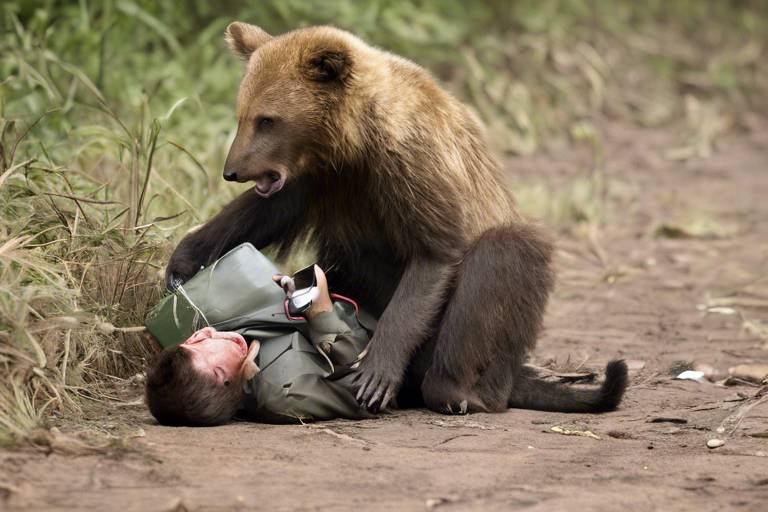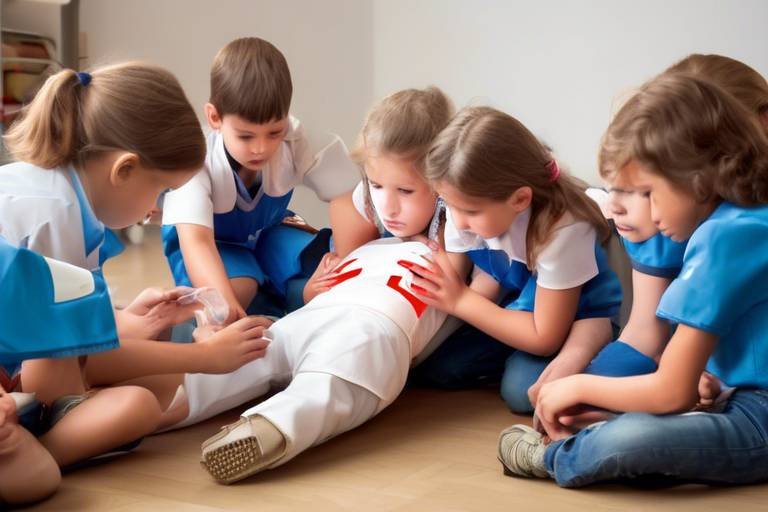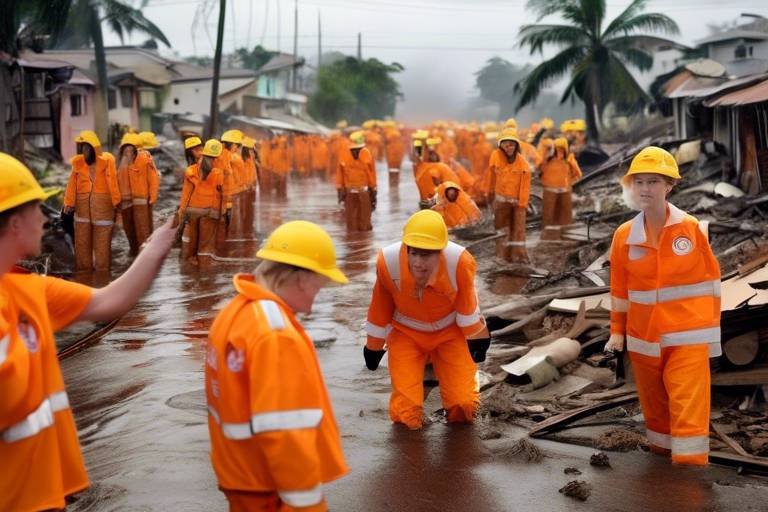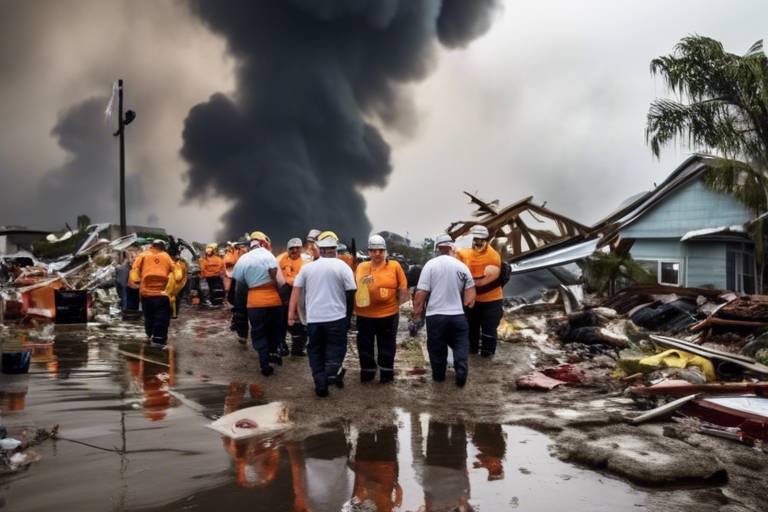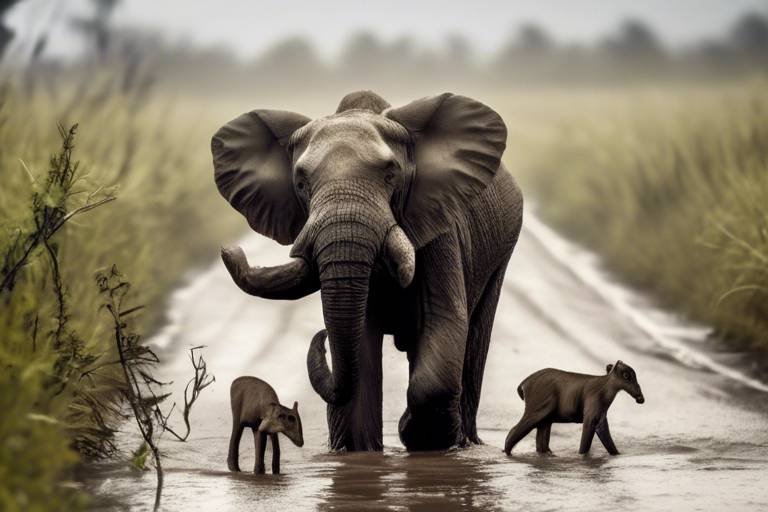Ways to Help Children Cope with Natural Disasters
This article explores effective strategies for supporting children during natural disasters, focusing on emotional resilience, communication, and practical preparedness to help them navigate these challenging experiences. Natural disasters can strike at any moment, leaving both adults and children feeling vulnerable and scared. It's essential to recognize that children may not have the same coping mechanisms as adults, and their emotional responses can be quite different. By understanding their feelings and equipping them with the right tools, we can help them emerge stronger from these situations.
Recognizing how children perceive and process emotions during disasters is crucial. Children often experience a whirlwind of feelings, ranging from fear and anxiety to confusion and sadness. It's important to validate these emotions rather than dismiss them. When a child expresses fear about a storm, for example, acknowledging that it's okay to feel scared can foster a sense of trust and emotional safety. This validation can be the first step in helping them build resilience. Remember, children look to adults for cues on how to react, so modeling calmness and understanding can go a long way in helping them navigate their feelings.
Open and honest communication can help children feel secure. Discussing natural disasters in a way that is age-appropriate is key. For younger children, it may be beneficial to explain what a natural disaster is using simple terms and relatable examples. For instance, comparing a hurricane to a big, angry storm can help them visualize the situation without becoming overwhelmed. As you talk, reassure them that they are safe and that you are there to protect them. It's also important to encourage them to express their fears and concerns, letting them know that their feelings are valid.
Tailoring conversations to a child's developmental stage can enhance understanding. Use simple language and relatable examples to explain complex situations. For instance, instead of saying, "We need to evacuate because of the impending natural disaster," you could say, "We need to leave our house for a little while because a big storm is coming, but we will be safe together." This way, children can grasp the situation without feeling overwhelmed by technical jargon or frightening details.
Inviting children to ask questions can help them process their thoughts and feelings. Create a safe space for inquiry by saying things like, "What are you wondering about?" or "Is there anything that makes you feel scared?" This approach not only helps children articulate their fears but also reassures them that it's okay to talk about their feelings. When they ask questions, respond with honesty, keeping their age in mind, and provide information that can help alleviate their concerns.
Practicing active listening ensures children feel heard and understood. When they share their thoughts, show that you are engaged by maintaining eye contact and nodding. Repeat back what they say to demonstrate understanding, such as, "I hear you saying that you’re worried about the loud noises during the storm." This technique not only validates their feelings but also builds a stronger emotional connection between you and the child, making them feel supported during tough times.
Teaching coping strategies can empower children to manage their emotions. Engaging in activities that promote emotional strength can be beneficial. For example, you might encourage them to express their feelings through art or storytelling. Discussing past experiences where they overcame challenges can also help. Remind them of a time they faced a storm and felt safe because of your support. This reinforces the idea that they can handle difficult situations and emerge stronger.
Having a well-defined emergency plan can provide children with a sense of security. When children know what to expect in the event of a disaster, they are less likely to feel anxious. An effective family emergency plan should include the following components:
- Emergency Contacts: List important phone numbers, including family members and local emergency services.
- Meeting Places: Designate safe locations for your family to gather in case of evacuation.
- Emergency Kit: Ensure that you have a kit ready with essentials like water, food, and first-aid supplies.
Engaging children in the planning process can enhance their understanding and preparedness. Allow them to help create the emergency kit or choose the meeting places. This involvement gives them a sense of control and ownership over their safety. You can even turn it into a fun family activity, reinforcing the idea that being prepared is important and can be a team effort.
Regularly practicing emergency drills helps children feel more confident and prepared. Just like fire drills at school, practicing at home can make a significant difference. Set a specific time to go through the emergency plan together, ensuring everyone knows their roles. This routine can help reduce anxiety during an actual event, as children will feel more familiar with the process and know what to expect.
Q: How can I tell if my child is struggling after a disaster?
A: Look for changes in behavior, such as increased clinginess, nightmares, or withdrawal from activities they once enjoyed. If these behaviors persist, consider reaching out to a mental health professional.
Q: What should I do if my child refuses to talk about the disaster?
A: Respect their feelings and give them space, but gently encourage them to express themselves when they are ready. You can also suggest creative outlets like drawing or writing.
Q: How can I help my child feel safe during a disaster?
A: Reassure them that you are there to protect them. Establish a routine during emergencies and involve them in the planning process to give them a sense of control.

Understanding Children's Emotions
When a natural disaster strikes, it’s not just the physical impact that leaves a mark; the emotional toll on children can be profound. Kids are like little sponges, absorbing the chaos and fear around them, often without fully understanding what’s happening. They may experience a whirlwind of emotions—fear, confusion, sadness, and even anger. It’s essential for parents and caregivers to recognize these emotional responses and validate their feelings. By doing so, we can help them build the emotional resilience they need to cope with such challenging experiences.
Children often process emotions differently than adults. For instance, while an adult might articulate their feelings through conversation, a child might express themselves through play or artwork. This is why it’s crucial to observe their behavior closely. Are they withdrawing from activities they usually enjoy? Are they acting out more than usual? These signs can indicate that they’re struggling to process their emotions. Understanding these nuances can help us tailor our support effectively.
Moreover, it’s important to remember that children look to the adults in their lives for cues on how to react. If parents remain calm and composed, children are more likely to feel secure. On the other hand, if adults are visibly shaken, children might interpret this as a signal that they should be scared. This leads to a cycle of anxiety that can be hard to break. Therefore, fostering an environment where children feel safe to express their feelings is paramount.
To further understand children’s emotional responses during disasters, let’s consider some common reactions:
- Fear: Children may fear for their safety or the safety of loved ones.
- Confusion: They might not fully grasp the situation, leading to confusion about what to expect next.
- Sadness: Loss of homes, pets, or even familiar routines can lead to feelings of sadness.
- Anger: Some children may express their frustration through anger, feeling powerless in the face of disaster.
Validating these feelings is critical. When children express fear, for instance, acknowledging their feelings with statements like, "It's okay to feel scared; many people feel that way," can help them feel understood. This validation can foster resilience, allowing children to process their emotions in a healthier way. As adults, we can guide them through their feelings, helping them to understand that it’s normal to feel a range of emotions during such trying times.
In summary, understanding children's emotions during natural disasters involves recognizing their unique ways of processing feelings and providing a safe space for them to express themselves. By validating their emotions and modeling calmness, we can help children navigate the emotional landscape of disasters, ultimately fostering resilience and emotional strength.

Effective Communication Strategies
When it comes to helping children cope with the aftermath of natural disasters, effective communication is key. Children, much like sponges, absorb the emotions and information around them, and if we’re not careful, they can soak up fear and confusion. So, how can we ensure that our conversations with them are not only informative but also reassuring? The answer lies in being open and honest while also being sensitive to their developmental stage.
First off, it’s important to recognize that children may not fully understand the complexities of a disaster. They might see images on the news or hear adults talking, but without context, these experiences can be overwhelming. By using age-appropriate language, we can bridge that gap. For example, instead of saying “natural disaster,” you might explain it as “a big storm or earthquake that can cause damage.” This simple shift can make a world of difference in how they perceive the situation.
Moreover, creating a safe space for children to express their feelings is essential. Encouraging questions is a powerful tool in this regard. When kids ask about a disaster, it shows they are trying to make sense of what they’ve experienced or heard. Instead of shying away from their inquiries, embrace them! You might say, “That’s a great question! Let’s talk about it together.” This not only validates their feelings but also opens up a dialogue that can help them process their emotions.
Another vital aspect is practicing active listening techniques. This means giving your full attention when a child speaks. It’s not just about hearing their words; it’s also about understanding their emotions. You can nod, maintain eye contact, and even repeat back what they’ve said to show you’re engaged. For instance, if a child expresses fear about storms, you might respond with, “I hear you. It’s scary to think about, isn’t it? But remember, we have safety plans in place.” This reinforces their sense of security while also acknowledging their feelings.
To wrap it up, effective communication isn’t just about sharing information; it’s about building a connection. When children feel heard and understood, they’re more likely to express their emotions and concerns. So, as you navigate these tough conversations, keep in mind the importance of empathy, clarity, and reassurance. By doing so, you’re not only helping them cope but also empowering them to face the challenges ahead with confidence.

Using Age-Appropriate Language
When it comes to discussing natural disasters with children, using age-appropriate language is vital. Imagine trying to explain a complex situation like a hurricane to a five-year-old using scientific jargon. It would be like trying to teach a cat to swim—frustrating and largely unsuccessful! Children process information differently depending on their developmental stage, so it’s essential to tailor our conversations to match their understanding.
For younger children, simple words and short sentences are key. Instead of saying, “The atmospheric conditions are conducive to severe weather,” you might say, “The weather is going to be really bad. We need to stay safe.” This kind of language is not only easier for them to grasp but also helps them feel less overwhelmed. Using relatable examples can also make a significant difference. For instance, you might compare a thunderstorm to a loud concert they’ve attended, something they can visualize and understand.
As children grow older, they develop a better grasp of abstract concepts. However, even with older kids, it’s important to avoid overwhelming them with too much information at once. Instead, provide details in small bites, allowing them to digest what you’ve said before moving on to the next point. For example, you could start with the basics of what a natural disaster is and gradually introduce more complex ideas, like how to prepare for one. This method not only helps them understand but also keeps them engaged in the conversation.
Another effective strategy is to encourage children to express their thoughts and feelings about disasters. By inviting them to share what they understand, you can gauge their comprehension and clear up any misconceptions. For instance, if a child believes that a tornado can come into their house and take them away, you can gently correct this notion while explaining what actually happens during a tornado. This two-way communication fosters a sense of safety and trust, allowing children to feel more secure in discussing their fears.
In addition to verbal communication, using visual aids can also be beneficial. Simple drawings, diagrams, or even videos can help illustrate your points. For example, showing a picture of a safe room can help them visualize where they should go during an emergency. This not only aids in their understanding but also makes the conversation more interactive and less intimidating.
In summary, using age-appropriate language is about more than just simplifying words; it’s about creating a safe space for children to learn and express their feelings. By being mindful of their developmental stage and encouraging open dialogue, we can help children navigate the complexities of natural disasters with confidence and resilience.

Encouraging Questions
When it comes to helping children navigate the emotional turbulence that often accompanies natural disasters, one of the most effective strategies is to encourage questions. Kids are naturally curious, and allowing them to voice their concerns can be a powerful tool in processing their feelings. Think of it like opening a window in a stuffy room; it lets in fresh air and clears out the confusion and anxiety that can build up inside. By creating a safe space for children to express their thoughts, you not only validate their feelings but also foster an environment of trust and communication.
So, how can you encourage your child to ask questions? Start by letting them know that it's completely normal to feel scared or confused during such events. You might say something like, "It's okay to have questions about what we just saw on the news. I'm here to help you understand." This simple reassurance can make a world of difference. When children know it’s safe to ask, they’re more likely to open up about their worries, whether it’s about the disaster itself, their safety, or even the well-being of their friends and family.
Another effective technique is to use open-ended questions to prompt discussion. Instead of asking, "Are you scared?" try something like, "What do you think about what happened?" This invites them to share their thoughts and feelings without feeling pressured to give a specific answer. It’s like giving them the keys to a treasure chest of emotions, allowing them to explore and articulate what’s inside. Remember, the goal is to listen actively and respond thoughtfully, making them feel heard and understood.
Additionally, it’s beneficial to share age-appropriate information about the disaster. You can explain what happened in a way that’s relatable to them. For example, if a hurricane is approaching, you might compare it to a big storm they’ve experienced before, helping them grasp the concept without overwhelming them with fear. This not only aids in their understanding but also encourages them to ask follow-up questions, further deepening the conversation.
Lastly, always be patient. Sometimes children may take time to articulate their thoughts or might ask the same questions repeatedly. This is a normal part of their processing. By remaining calm and supportive, you’re teaching them that it’s okay to seek clarity and reassurance, which is a vital lesson in emotional resilience. Just like a tree bends with the wind but doesn’t break, children can learn to adapt and grow stronger through these conversations.
- How can I tell if my child is struggling with their emotions after a disaster? Look for changes in behavior, such as increased clinginess, nightmares, or withdrawal from activities they once enjoyed. Open communication is key.
- What age is appropriate to start discussing disasters with my child? It varies by child, but generally, you can start having age-appropriate conversations as soon as they begin to understand the world around them.
- Should I share all the details of a disaster with my child? No, it’s important to tailor the information to their age and emotional maturity. Focus on the facts and reassure them about their safety.
- How can I help my child feel safe during a disaster? Create a family emergency plan together and practice it regularly. Familiarity helps reduce anxiety.

Active Listening Techniques
Active listening is more than just hearing words; it's about truly understanding what a child is feeling and expressing. When children experience the turmoil of a natural disaster, they often have a whirlwind of thoughts and emotions that need to be processed. As parents and caregivers, it’s our responsibility to create a safe environment where they can share their feelings without fear of judgment. One effective technique is to maintain eye contact and use encouraging nods or verbal affirmations like "I see" or "I understand." This non-verbal communication signals to the child that you are fully engaged in their experience.
Another important aspect of active listening is to paraphrase what the child has said. This not only shows that you are paying attention but also helps clarify their thoughts. For example, if a child expresses fear about a storm, you might respond with, "It sounds like you’re really scared about the thunder." This technique validates their feelings and encourages them to elaborate further, which is essential for emotional processing.
Moreover, it’s crucial to avoid interrupting or jumping to conclusions. Instead, allow them to express themselves completely before responding. If they mention something that surprises you, resist the urge to react immediately. Instead, take a moment to digest their words and respond thoughtfully. This approach fosters a trusting relationship where children feel safe to share their vulnerabilities.
In addition to these techniques, creating a comfortable atmosphere can significantly enhance active listening. Find a quiet space where distractions are minimized, and perhaps sit down at their level. This physical positioning can make a big difference in how open they feel to communicate. Remember, children often mirror the emotional states of adults, so maintaining a calm and reassuring demeanor can help them feel more at ease.
Finally, it’s essential to ask open-ended questions that encourage deeper reflection and sharing. Instead of asking, "Are you scared?" try "What do you think about what happened?" This invites them to explore their emotions more fully and can lead to a richer conversation. By using these active listening techniques, you not only help children articulate their feelings but also empower them to develop their emotional resilience in the face of adversity.
- What is active listening? Active listening is a communication technique that involves fully concentrating, understanding, responding, and remembering what is being said.
- Why is active listening important for children? It helps children feel heard and understood, which is crucial for their emotional development, especially during stressful situations like natural disasters.
- How can I practice active listening with my child? Maintain eye contact, paraphrase their feelings, avoid interruptions, create a comfortable environment, and ask open-ended questions.

Building Emotional Resilience
Building emotional resilience in children is like equipping them with a sturdy umbrella before a storm. Just as an umbrella shields us from raindrops, resilience helps children navigate the emotional challenges that arise during and after natural disasters. It’s essential to teach them coping strategies that empower them to manage their feelings effectively. One effective way to cultivate resilience is through engaging discussions about emotions. When children express their fears or anxieties, responding with empathy and understanding can create a safe space for them to explore their feelings.
Additionally, incorporating activities that promote emotional strength can be incredibly beneficial. For instance, creative outlets such as drawing, storytelling, or role-playing can serve as powerful tools for children to express themselves. These activities not only provide a distraction but also help them articulate their thoughts and emotions in a constructive manner. By allowing children to create narratives around their experiences, we can encourage them to see challenges from different perspectives, thus enhancing their emotional toolkit.
Furthermore, teaching children mindfulness techniques can significantly bolster their resilience. Mindfulness practices, such as deep breathing exercises or simple meditation, can help children center themselves during moments of distress. Imagine teaching a child to take a deep breath and visualize a calm place; this technique not only grounds them but also reinforces the idea that they have control over their emotional responses. Regular practice of these techniques can transform a child's approach to stress, making them more adaptable and resilient in the face of adversity.
Another vital component of building resilience is fostering a strong support network. Encourage children to maintain connections with family and friends, as these relationships can provide comfort and stability. When children know they have people who care about them, they are more likely to feel secure and supported. Engaging in community activities, such as volunteering or participating in local events, can also instill a sense of belonging and purpose, further enhancing their emotional resilience.
In summary, building emotional resilience in children is not a one-time event but an ongoing process. It requires consistent effort, open communication, and the integration of various coping strategies into their daily lives. By equipping children with these essential skills, we prepare them to face life's storms with confidence and strength.
- What are some signs that my child is struggling emotionally after a disaster? Look for changes in behavior, such as increased anxiety, withdrawal from activities, or changes in sleep patterns.
- How can I encourage my child to express their feelings? Create a safe environment where they feel comfortable sharing their thoughts. Use open-ended questions and be patient as they process their emotions.
- What activities can help build resilience in children? Activities like art, storytelling, and mindfulness exercises can significantly help children express themselves and develop coping strategies.
- How important is a support network for a child's emotional resilience? A strong support network is crucial as it provides children with a sense of security and belonging, which are essential for emotional well-being.

Creating a Family Emergency Plan
When it comes to protecting our children during natural disasters, having a well-defined family emergency plan is like having a safety net. It provides not just a sense of security but also a roadmap for navigating the uncertainties that come with emergencies. Imagine walking through a dark forest; having a flashlight can illuminate the path and make the journey less daunting. Similarly, an emergency plan can guide your family through the chaos of a disaster.
In crafting an effective emergency plan, it’s essential to consider several key components. First, you need to identify your family’s specific needs and the types of disasters that are most likely to occur in your area. This could range from hurricanes and floods to earthquakes or wildfires. Understanding these factors allows you to tailor your plan accordingly.
Next, it’s crucial to establish communication protocols. In the event of a disaster, your family may be separated, and knowing how to reconnect is vital. Consider creating a list of emergency contacts that includes family members, friends, and local authorities. Make sure your children know how to reach these contacts and practice using their phones or other communication devices.
Another important aspect is to create a safe meeting place. This should be a location that is easily accessible and known to all family members. Whether it’s a neighbor’s house, a local park, or a community center, having a designated spot helps to alleviate anxiety and confusion during a crisis. It’s like having a lighthouse guiding ships safely to shore.
Involving your children in the planning process is not just beneficial; it’s empowering. When children participate in discussions about the emergency plan, they gain a sense of ownership and understanding. You might ask them questions like, “What would you do if we couldn’t reach each other?” or “Where do you think we should meet if we get separated?” This not only engages them but also helps them think critically about the situation.
Practicing the emergency plan through regular drills is essential. Just like fire drills in school, these practice sessions help children know what to expect and how to react when the real situation occurs. During these drills, you can simulate various scenarios, such as evacuating the house or finding a safe space. Repetition builds confidence, and confidence is key in managing fear.
Finally, keep your emergency plan updated. As your children grow and your family dynamics change, so too should your plan. Regularly review and revise the details, ensuring that everyone is on the same page and prepared for any eventuality. You might even consider creating a family emergency plan binder that includes all necessary information, such as contact numbers, meeting places, and emergency procedures.
In summary, creating a family emergency plan is not just about having a document; it’s about fostering a culture of preparedness and resilience within your family. By involving your children, practicing regularly, and keeping the plan updated, you’re not only equipping them with the tools to handle disasters but also instilling a sense of confidence that they can carry with them throughout their lives.
- What should be included in a family emergency plan?
Your plan should include emergency contacts, meeting places, evacuation routes, and specific roles for each family member.
- How often should we practice our emergency plan?
It's recommended to practice your emergency plan at least twice a year, or more frequently if your family dynamics change.
- How can I help my child feel more secure during a disaster?
Open communication, reassurance, and involving them in the planning process can significantly enhance their sense of security.
- What are some common emotional responses children may have during a disaster?
Children may experience fear, confusion, anger, or sadness. It's important to validate their feelings and provide support.

Involving Children in Planning
When it comes to preparing for emergencies, involving children in the planning process is not just beneficial—it's essential! Think of it as giving them a role in a team where everyone has a part to play. By including them in discussions about safety and preparedness, you not only empower them but also help them feel more secure and in control. Imagine how much more confident they will feel knowing they had a say in what to do when disaster strikes!
Start by gathering the family together for a casual meeting. Make it a fun and engaging experience! You can use visuals, like drawings or charts, to illustrate your family emergency plan. This approach makes it easier for children to grasp complex ideas. For instance, you could create a simple family emergency contact sheet that includes important phone numbers and addresses. Encourage your children to help design it, perhaps by adding their own drawings or stickers. This way, they are not just passive listeners; they become active participants in their own safety.
Another effective strategy is to role-play different scenarios. This method allows children to practice what they would do in a real emergency, making the learning experience more tangible. For example, you could simulate a fire drill or a severe weather warning. Ask them questions like, “What would you grab if you had to leave quickly?” or “Where would we meet if we got separated?” This kind of engagement not only teaches them practical skills but also helps them articulate their feelings about emergencies, which can be incredibly valuable.
It's also important to keep the lines of communication open. After the planning sessions, regularly check in with your children to see how they feel about the plans. Are there any parts they find confusing? Do they have any fears they want to discuss? By maintaining this dialogue, you're not just preparing them for emergencies; you're also fostering a safe space for them to express their emotions. Remember, the goal is to create a sense of teamwork and trust within the family, so everyone feels supported.
Lastly, don't forget to celebrate your preparedness efforts! Whether it's a small family dinner or a fun activity, recognizing the work you've all done together reinforces the importance of being prepared. This not only solidifies the knowledge but also creates positive memories associated with planning. Involving children in emergency planning is like planting seeds of resilience that will grow and flourish, equipping them with the skills they need to navigate the unpredictable world around them.
- Why is it important to involve children in emergency planning? Involving children helps them feel empowered and secure, making them more likely to remember and follow through with emergency plans.
- What age is appropriate for children to start participating in planning? Children as young as preschool age can begin to understand basic concepts of safety and preparedness, while older children can engage in more detailed planning.
- How can I make emergency planning fun for my kids? Use games, role-playing, and creative activities like drawing or crafting to make the planning process engaging and enjoyable.

Practicing Emergency Drills
Practicing emergency drills is like putting on a safety belt before driving; it’s a proactive step that can make all the difference when the unexpected happens. Just as we buckle up to protect ourselves, conducting regular drills helps children understand what to do in case of a natural disaster. When kids know the plan, they feel more secure and less anxious. This preparation transforms fear into confidence, and that’s a powerful change!
Imagine a scenario where a sudden storm hits your area. If your child has practiced what to do—whether it’s going to a designated safe space in your home or knowing how to reach out to emergency services—they're less likely to panic. Instead, they can take action. This is why it’s essential to incorporate emergency drills into your family routine. Not only does it prepare children, but it also reinforces the importance of safety in a fun and engaging way.
To make the most out of these drills, consider the following key points:
- Frequency: Aim to practice drills at least twice a year. This ensures that the information stays fresh in their minds.
- Variety: Simulate different scenarios. For instance, practice what to do during an earthquake one time, and then switch it up with a fire drill the next.
- Involvement: Involve your children in the planning process. Let them help decide on safe spots in the house or what supplies to include in an emergency kit.
After each drill, take a moment to sit down with your child and discuss how they felt during the exercise. Did they find it easy to remember the steps? Were they scared or excited? This reflection is crucial, as it allows them to process their emotions and reinforces their learning. By doing this, you're not just preparing them physically; you're also nurturing their emotional resilience.
Another great idea is to turn these drills into a game. Kids love to play, and when you incorporate fun elements—like a race to the safe spot or a scavenger hunt for emergency supplies—they're more likely to engage and remember the procedures. You can even create a reward system for participation, which adds motivation and reinforces the importance of being prepared.
As you practice these drills, remember to keep the communication lines open. Ask your children how they feel about the drills and if they have any suggestions for improvement. This not only empowers them but also strengthens their sense of control in a situation that can feel overwhelming. Ultimately, the goal is to ensure that when disaster strikes, your child knows they have the tools and knowledge to respond effectively.
In conclusion, practicing emergency drills is not just about memorizing steps; it's about building a culture of safety within your family. By making it a regular part of your lives, you’re equipping your children with the skills they need to stay calm and act decisively when it matters most.
Q: How often should we practice emergency drills?
A: It’s recommended to practice emergency drills at least twice a year, but you can increase the frequency if you feel it’s necessary, especially after any significant weather events.
Q: What types of emergencies should we prepare for?
A: Focus on the types of disasters that are most likely to occur in your area, such as earthquakes, floods, fires, or severe storms. Tailor your drills accordingly.
Q: How can I make drills more engaging for my children?
A: Turn drills into games, involve them in planning, and use rewards to encourage participation. Keeping it fun will help them remember the procedures better.
Q: Should I discuss the details of disasters with my children?
A: Yes, but be mindful of their age and emotional readiness. Use age-appropriate language and encourage questions to help them process their feelings.
Frequently Asked Questions
- How can I help my child understand what a natural disaster is?
It's important to use age-appropriate language when discussing natural disasters. Start by explaining what a natural disaster is in simple terms, using relatable examples. For younger children, you might say, "Sometimes, nature can be very strong, like when a big storm comes." This helps them grasp the concept without overwhelming them.
- What should I do if my child is scared after a disaster?
Validate their feelings by letting them know it's okay to be scared. Encourage them to express their emotions and reassure them that you’re there to protect them. Engaging in comforting activities, like reading a book or drawing, can also help them process their feelings.
- How can I create a family emergency plan?
Start by discussing the types of emergencies that could happen in your area. Together with your child, outline a plan that includes escape routes, meeting points, and essential contacts. Make it a fun activity by using colorful drawings or maps, so they feel involved and informed.
- What role should children play in emergency drills?
Involving children in emergency drills can significantly boost their confidence. Let them take on roles, such as leading the way or checking off items on a safety checklist. This not only empowers them but also reinforces the importance of preparation in a hands-on way.
- How can I encourage my child to ask questions about disasters?
Create a safe space for dialogue by being open and approachable. You might say, "If you have any questions about storms or earthquakes, you can always ask me!" This encourages them to share their thoughts and curiosities, making it easier for them to process information.
- What are some coping strategies I can teach my child?
Introduce simple coping strategies like deep breathing or counting to ten when they feel anxious. You can also engage them in creative outlets like drawing or playing pretend scenarios, which can help them express their feelings and develop emotional resilience.

